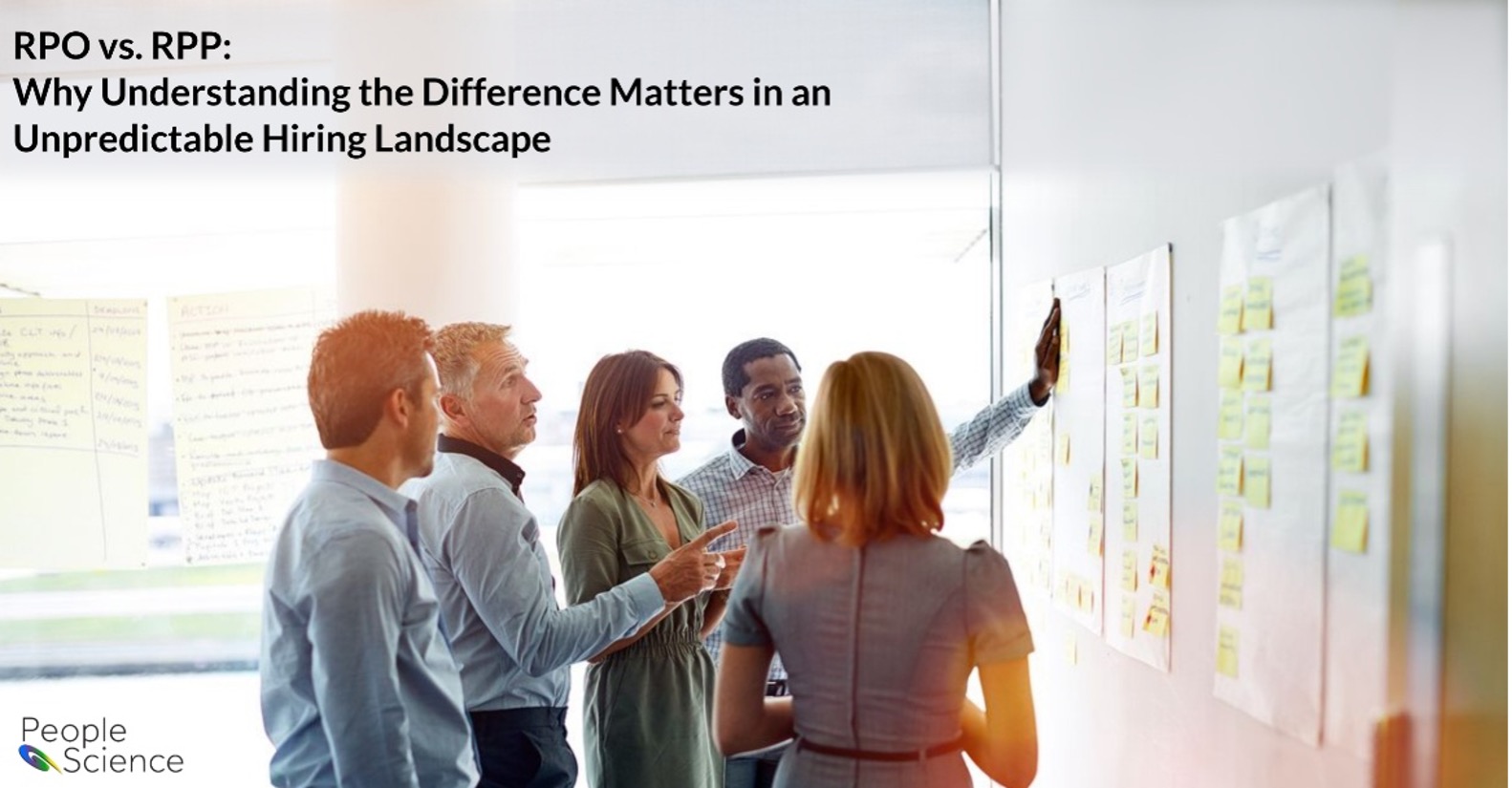Understanding the difference between RPO vs RPP has become increasingly important as hiring needs grow more unpredictable. Most leaders are familiar with Recruitment Process Outsourcing (RPO) – it’s been part of the talent acquisition vocabulary for decades. But as hiring needs have become more unpredictable, many organizations have found that traditional RPO models don’t always align with the way they work today.
At People Science, we saw this gap repeatedly across industries: companies wanted outside support, but they didn’t want to fully outsource their recruiting function. They wanted flexibility, transparency, and collaboration. They wanted a partner who could work within their systems, not replace them.
That need didn’t fit neatly into the traditional definition of RPO.
So we named something we had already been doing for years: Recruitment Process Partnering (RPP).
RPP isn’t an industry-standard term yet because we created it. But it captures an approach that has become increasingly relevant in today’s environment: embedded collaboration instead of external outsourcing.
For organizations navigating rapid shifts, fluctuating hiring volumes, or internal restructuring, understanding the difference between RPO and RPP is more than a terminology distinction. It influences the level of control you maintain, how adaptable your recruiting function can be, and whether your talent acquisition approach can withstand volatility.
What RPO Traditionally Provides
These challenges highlight why understanding the differences in RPO vs RPP matters, especially in volatile hiring environments. Recruitment Process Outsourcing (RPO) became popular when companies needed stable, predictable hiring support at scale. The model generally involves handing over portions of the recruiting function to an external provider.
RPO tends to work best when:
- Hiring volumes are steady
- Job types are consistent
- Processes change slowly
- The organization prefers an outside team to run much of the operation
In today’s more variable hiring environment, some organizations find RPO challenging because:
- The model is usually built on fixed scopes or longer-term commitments
- External teams often run their own processes or technology rather than using the client’s
- Adjusting support levels can take time when priorities shift
- The focus is frequently on filling roles rather than improving underlying systems
These limitations matter more in an economy where hiring needs can change almost overnight.
What RPP Offers Instead
This is where the advantages of RPO vs RPP become clearer—RPP adapts quickly while still supporting internal teams. Recruitment Process Partnering (RPP) reflects a different way of working – one shaped by the realities of today’s labor market. Instead of outsourcing, RPP emphasizes integration and collaboration.
RPP typically involves:
1. Working within the organization’s existing systems and structures
Teams embed into the client’s technology, workflows, and communication channels. This maintains continuity and visibility as hiring needs fluctuate.
2. Flexibility built into the model
Because RPP is structured around partnership rather than preset volume assumptions, it can adapt more quickly when hiring demands grow or shrink.
3. Attention to both process and performance
RPP looks beyond open roles to examine processes, sourcing strategies, hiring manager expectations, and candidate experience. The focus is on improving the whole system, not just keeping up with requisitions.
4. Shared responsibility for outcomes
KPIs such as time-to-fill, funnel performance, and quality of hire are aligned collaboratively. Both sides contribute to achieving results.
5. Support for internal TA teams
RPP often complements rather than replaces internal recruitment staff. During periods of uncertainty, this creates stability and continuity.
Why the Distinction Matters When Choosing a Vendor
Making the right choice in RPO vs RPP has a direct impact on control, visibility, and long-term hiring resilience. When hiring needs shift quickly – up, down, or sideways – the structure of your support model becomes important. Choosing between RPO and RPP isn’t about which one is “better,” but which one aligns with your organization’s reality.
Here are a few considerations:
Control and visibility:
Organizations that want to keep ownership of their processes and systems may find RPP provides a better fit because the model works inside the existing structure.
Adaptability
RPO is traditionally built around predictable volume. RPP adjusts more naturally to volatility without requiring pauses or renegotiations.
Internal capability
If part of your goal is to strengthen your internal talent acquisition function, RPP supports that development rather than shifting the entire function externally.
Operational resilience
During hiring slowdowns or organizational changes, RPP can refocus on process improvement and strategic alignment without disengaging the partnership.
Choosing the Approach That Fits Your Needs
RPO and RPP both serve valid purposes, but they work best in different environments. RPO may be effective for organizations that want a long-term, externalized recruiting operation.
RPP is often a better fit for organizations facing variability, internal structural changes, or the need for tighter alignment between recruiting and business operations.
Understanding the difference helps organizations select the approach that supports, not restricts, their hiring strategy.
Final Thoughts
The shifts in today’s hiring landscape call for models that are adaptable, transparent, and collaborative. RPP emerged because many organizations needed a different kind of support, one that strengthens internal capability while remaining flexible enough to handle volatility.
Whether your organization is expanding, contracting, or recalibrating, clarity on the RPO vs. RPP distinction can help you choose a partnership model that supports your goals and prepares your talent acquisition function for whatever comes next.
